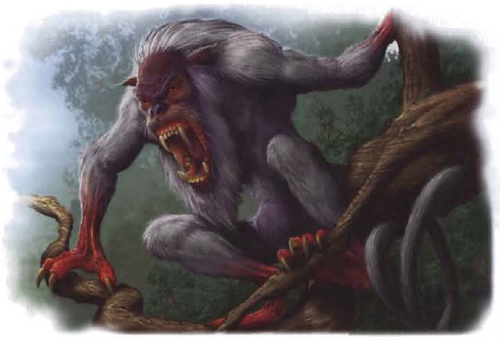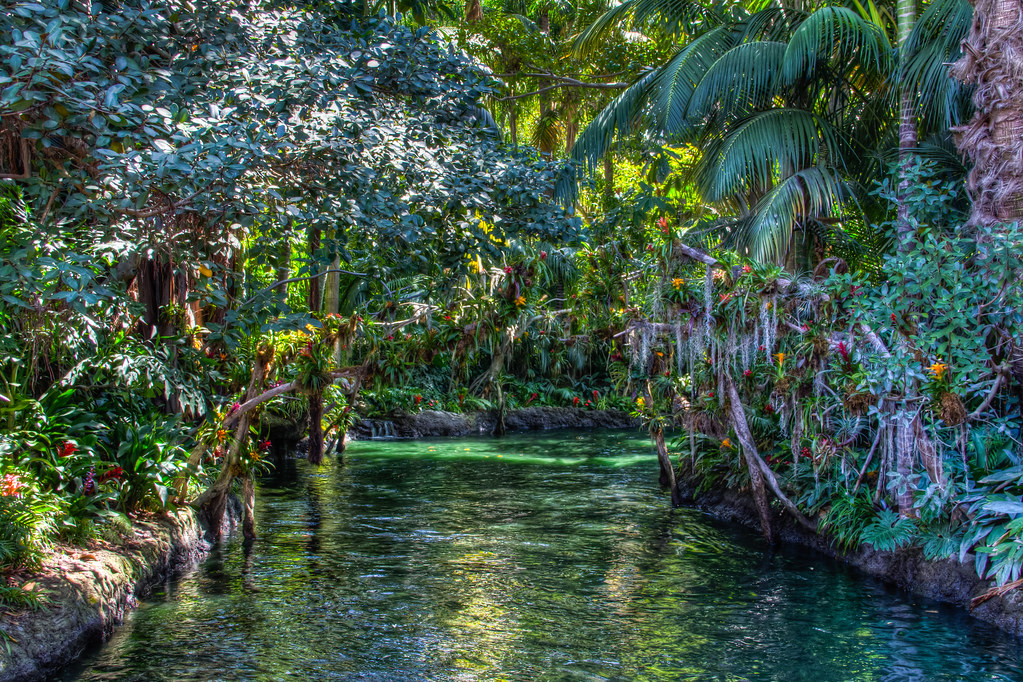This is part two of my jungle river generator. This can be used with the
river section table or on its own. It's a simple random encounter table that uses creatures mostly found in the 5e Monster Manual, a few of my own creations that can be found in my blog (follow the links) and a few extras.
Encounters:
Roll 2d20 at least once per day for random encounters or
whenever you think the party needs some excitement. Many encounters are not
meant for the players to engage. Some may
be too strong for the party and are intended to be avoided. Luckily a number of
river sections provide enough room to go around the monster (like a lake where
a hydra has made home on one of its far banks…enticing, but probably safer just
taking the long way around the other side of the lake). A few monsters will be
on a bank just watching the party (a congress of baboons in the trees). As long
as the party is in a part of the river that is wide enough or doesn't try to
land near these monsters, then they’ll typically pass safely. A lot of monsters
swarm as a survival tactic. Some have evolved unique characteristics to
increase their chances in the dangerous jungle.

If a party attempts to fight on vessels that hold less than
three people (like a rowboat), then attacks gain disadvantage due to the
instability of the vessel. If a player or creature is hit on small vessels,
they must make a save to stay in the boat (DEX DC 12).
Not all rolls will result in a creature appropriate for the
section of the river. Treat these rolls as a no encounter or roll again, if it’s
been too quiet. Don’t forget to give a good description of the surrounding
bank, some creatures are protecting their lairs or territories and some are trying to
lure prey to the shore.
2 – 1d4 Cockatrice (p. 42) – attacks from the air; found in
open sections of the river
3 – Displacer Beast (p. 81) – seen along the bank; 2d4 per
day chance it will follow the boats
4 – Plesiosaurus (p. 80) – found in deep water, like a lake
or middle of a large river
5 – 1d4 Dryads (p. 121) – protecting exceptionally large
trees on the bank; sometimes protecting an entire island in a braided section
or an overgrown section may be a protected tree
6 – Ettercap (p. 131) – the surrounding trees become covered
in thick spider webs that is the nest of the ettercap; if this creature is
found in an overgrown or underground section of the river, the party may be
forced to engage the creature.
7 – Stone Golem (p. 170) – single statue is seen standing
near the bank with vines and moss growing on it; the ruins of a temple surround
the golem; should only be approached with caution
8 – Green Hag (p.177) – a hag’s lair may be seen on the bank
or it may be hidden in the shadows; she may attempt to lure the party deep into
the jungle before attacking
9-10 – Something large moves through the jungle; trees shake
and breaking branches can be heard, but no one can see what’s causing the
activity
11 – Hydra (p. 190) – this is a very powerful creature and
should only be attempted by experienced or foolhardy parties; enough room
should be given to allow the party to go around, if desired.
12 – 4 to 10 Lizardfolk (p. 204) – one of the humanoid
tribes of the jungle; they’ll attack with their javelins from the bank or
attempt to lure the party to the shore
13 – 5 to 10 Stirge (p. 284) – living in the shadows of the
canopy or a large, hollow trunk, these creatures will attack the party as they
pass
14 – Water Weird (p. 299) – this elemental is a remnant from
a wizard that has been lost to time; the creature is in a pool and protects a
ruined tower
15 – Awakened Tree (p. 317) – the fey touched tree sits
still until prey gets close enough to attack; its branches may reach over the
river
16-17 – 10 Baboons (p. 318) – the troop sits in the trees
watching the party pass; if the party lands the boat close to the troop, they
may attack; poop throwing is optional
18-19 – Crocodile (p. 320) – a common creature found along
the banks or in the water of calmer waters; sometimes groups of crocodiles will
be found
20 – 4 to 8 Flying Snakes (p. 322) – groups of flying snakes
will launch themselves across rivers to attack passing prey
21-22 – Giant Constrictor Snake (p. 324) – a giant snake can
be seen hanging in a tree; if this creature is encountered in an over grown
area, avoiding the snake may be impossible
23-24 – Giant Frog (p. 325) – found sitting in the shadows
or muddy areas along the banks; may take to the water, if provoked
25-26 – Giant Wolf Spider (p. 330) – hides in burrows along
the bank; will ambush if the party lands their boat on a bank near the burrow
27-28 – Drums are heard in the distance. There source or
purpose are unknown.
29-30 – Swarm of Bats (p. 337) – found in nearly every area
of the river living inside trunks of large trees, but will usually only emerge
during late dusk; the exception is swarms found in caves.
31-32 – Swarm of Poisonous Snakes (p. 338) – large nest of
poisonous snakes can be found living in the low hanging branches of trees or
exposed roots at the base of large trees
33 – Swarm of Quippers (p. 338) 1 in 4 chance they are
flying; they may not be noticed unless something enters the water (
Flying Quippers)
34 – Panther (p. 333)
– prowls the banks and may follow the party for sometime; tracking the group
until the land their boat
35 –
Band of Chu’Mwarg (4 to 10) – small headhunters of the
jungles; they will track the party until they can attack
36 – Crazed Jungle Druid (p. 346) – watches from the
shadows; may attack if the party notices the druid or attempts to land on the
bank.
37-40 – Oddly quiet; the jungle seems to be still, almost as
if it’s watching and waiting.
 I've don't have a new monster this week that I can post. Kobold Press' Monarch of the Monster 5 has been taking up my time. You can still get in on the fun. Create a 5e monster and submit it by 23 Feb.
I've don't have a new monster this week that I can post. Kobold Press' Monarch of the Monster 5 has been taking up my time. You can still get in on the fun. Create a 5e monster and submit it by 23 Feb. Distance between shores is typically 25-75 yards across, but can be wider or narrower. The
exceptions are lake, overgrown and braided sections. The banks are thick with
jungle undergrowth and heavily shadowed by the dense canopy, not to mention the
occasional ancient ruins overgrown with vegetation.
Distance between shores is typically 25-75 yards across, but can be wider or narrower. The
exceptions are lake, overgrown and braided sections. The banks are thick with
jungle undergrowth and heavily shadowed by the dense canopy, not to mention the
occasional ancient ruins overgrown with vegetation.